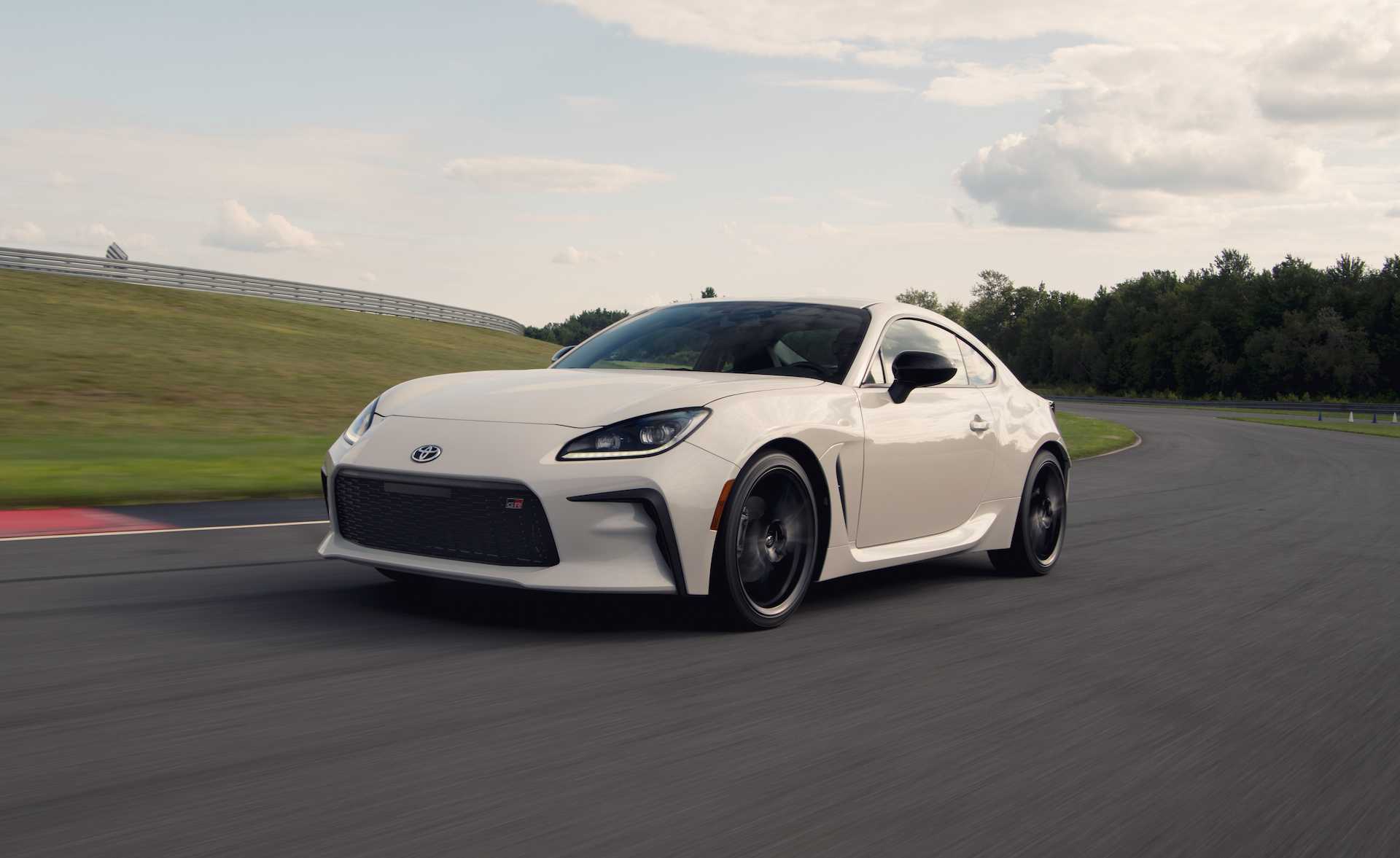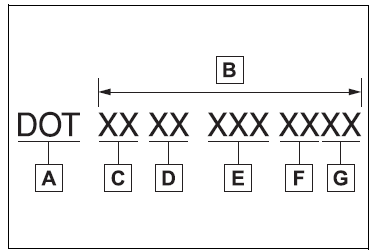Toyota 86 2022 Specifications User Guide
Maintenance data (fuel, oil level, etc.)
Dimensions and weight
| Overall length | 167.9 in. (4265 mm) | |
| Overall width | 69.9 in. (1775 mm) | |
| Overall height* | 51.6 in. (1310 mm) | |
| Wheelbase | 101.4 in. (2575 mm) | |
|
Tread |
Front | 59.8 in. (1520 mm) |
| Rear | 61.0 in. (1550 mm) | |
| Vehicle capacity weight (Occupants + lug- gage) | Details are described on the tire and loading information label. (®P.324) | |
Seating capacity
Seating capacity 4 (Front 2, Rear 2)
Vehicle identification
- Vehicle identification number The vehicle identification number (VIN) is the legal identifier for your vehicle. This is the primary identification number for your Toyota. It is used in registering the ownership of your vehicle.
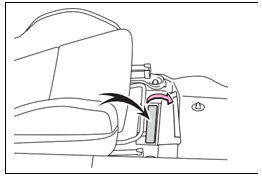
- This number is stamped under the right-hand front seat. This number is located on the top left of the body panel
- This number is also on the Certification Label. The vehicle model type, vehicle identification number, etc. are on the manufacturer’s label

Engine number
The engine number is stamped on the engine block as shown
Engine
| Model | FA24 |
| Type | Horizontally opposed, liquid cooled 4 cylinder, 4-stroke gasoline |
| Bore and stroke | 3.70 ´ 3.39 in. (94.0 ´ 86.0 mm) |
| Displacement | 146 cu. in. (2387 cm3) |
| Drive belt tension | Automatic adjustment |
Fuel
| Fuel type | Unleaded gasoline only |
| Octane Rating | 93 (Research octane number 98) or higher* |
| Fuel tank capacity (Reference) | 13.2 gal. (50.0 L, 11.0 Imp. gal.) |
Lubrication system
Oil capacity (Drain and refill (Reference)
The engine oil capacity is a reference quantity to be used when changing the engine oil. Warm up and turn off the engine, wait more than 5 minutes, and check the oil level on the dipstick
| With filter | 5.3 qt. (5.0 L, 4.4 Imp. qt.) |
| Without filter | 5.1 qt. (4.8 L, 4.2 Imp. qt.) |
Engine oil selection
“Toyota Genuine Motor Oil” is used in your Toyota vehicle. Use Toyota approved “Toyota Genuine Motor Oil” or equivalent to satisfy the following grade and viscosity. Oil grade: ILSAC GF-6A multigrade engine oil Recommended viscosity: SAE 0W-20 SAE 0W-20 is the best choice for good fuel economy and good starting in cold weather. If SAE 0W-20 is not available, SAE 5W-20 oil may be used. However, it must be replaced with SAE 0W-20 at the next oil change.
Outside temperature
Oil viscosity (0W-20 is explained here as an example):
- The 0W in 0W-20 indicates the characteristic of the oil which allows cold startability. Oils with a lower value before the W allow for easier starting of the engine in cold weather.
- The 20 in 0W-20 indicates the viscosity characteristic of the oil when the oil is at high temperature. An oil with a higher viscosity (one with a higher value) may be better suited if the vehicle is operated at high speeds, or under extreme load conditions.
How to read oil container label:
The International Lubricant Specification Advisory Committee (ILSAC) Certification Mark is added to some oil containers to help you select the oil you should use.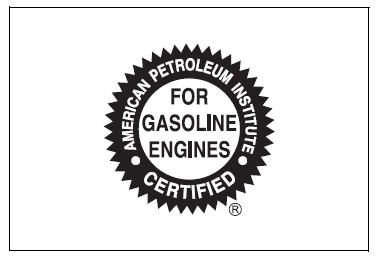
Cooling system
|
Capacity |
u Vehicles with an automatic transmission
8.1 qt. (7.7 L, 6.8 Imp. qt.) u Vehicles with a manual transmission 7.8 qt. (7.4 L, 6.5 Imp. qt.) |
|
Coolant type |
Use either of the following.
· “TOYOTA Genuine 50/50 Pre-mixed Super Long Life Coolant BLUE” · Similar high-quality ethylene glycol-based non-silicate, non-amine, non-nitrite, and non-borate coolant with long-life hybrid organic acid technology Do not use plain water alone. |
Ignition system (spark plug)
| Make Gap | DENSO ZXE27HBR8
0.031 in. (0.8 mm) |
NOTICE
Iridium-tipped spark plugs
Use only iridium-tipped spark plugs. Do not adjust gap when tuning engine.
Electrical system
| Battery
Specific gravity reading at 68°F (20°C): |
1.250¾1.290 Fully charged 1.160¾1.200 Half charged 1.060¾1.100 Discharged |
| Charging rates Quick charge
Slow charge |
15 A max. 5 A max. |
Differential
Your Toyota vehicle is filled with “Toyota Genuine Differential Gear Oil LX” at the factory. Use Toyota approved “Toyota Genuine Differential Gear Oil LX” or an equivalent of matching quality to satisfy the above specification. Please contact your Toyota dealer for further details.
| Oil capacity (Reference) | 1.22 qt. (1.15 L, 1.01 Imp. qt.) |
|
Oil type and viscosity* |
· Toyota Genuine Differential Gear Oil LX
· Other LSD gear oil that meets API GL-5 and SAE 75W-85 |
NOTICE
Differential gear oil type
Using a differential gear oil other than “Toyota Genuine Differential Gear Oil LX” may cause occurrences of noises, vibrations and poor fuel consumption. Never use different brands together.
Automatic transmission
| Fluid capacity* | 7.9 qt. (7.5 L, 6.6 Imp. qt.) |
| Fluid type | Toyota Genuine ATF WS |
NOTICE
Transmission fluid type
Using automatic transmission fluid other than “TOYOTA Genuine ATF WS” may cause deterioration in shift quality, locking up of your transmission accompanied by vibration, and ultimately damage the automatic transmission of your vehicle.
Manual transmission
| Fluid capacity* | 2.3 qt. (2.2 L, 1.9 Imp. qt.) |
|
Fluid type |
Use either of the following:
· “MT GEAR OIL LV 75W” · Other gear oil that meets API GL-4* and SAE 75W specifications |
NOTICE
Transmission fluid type
- If oil other than “MT GEAR OIL LV 75W” is used, the following may be experienced:
- The overall performance and function of the transmission may be adversely affected.
- Rattling noises may occur during idling and fuel consumption may increase.
- Never use different brands together.
Clutch
| Pedal free play | 0.17¾0.65 in. (4.3¾16.4 mm) |
| Fluid type | SAE J1703 or FMVSS No.116 DOT 3 |
Brakes
| Pedal clearance*1 | 2.91 in. (74 mm) Min. |
| Pedal free play | 0.020¾0.059 in. (0.5¾1.5 mm) |
|
Brake pad wear limit |
Fro nt | 0.06 in. (1.5 mm) |
| Rea r | 0.06 in. (1.5 mm) | |
| Parking brake lining wear limit | 0.06 in. (1.5 mm) | |
| Parking brake lever travel*2 | 7 – 8 clicks | |
| Fluid type | SAE J1703 or FMVSS No.116 DOT 3 | |
Minimum pedal clearance when depressed with a force of 67 lbf (300 N, 30 kgf) while the engine is running.
- Carpet
- Brake pedal
- Pedal clearance

Steering
| Free play | Less than 1.2 in. (30 mm) |
Tires and wheels
TYPE A
| Tire size | 215/45R17 87W |
| Tire inflation pressure (Recommended cold tire inflation pressure) | Front: 35 psi (240 kPa, 2.4 kgf/cm2 or bar)
Rear: 35 psi (240 kPa, 2.4 kgf/cm2 or bar) |
| Wheel size | 17 ´ 7 1/2 J |
| Wheel nut torque | 89 ft•lbf (120 N•m, 12.2 kgf•m) |
TYPE B
| Tire size | 215/40R18 85Y |
| Tire inflation pressure (Recommended cold tire inflation pressure) | Driving under normal conditions
Front: 35 psi (240 kPa, 2.4 kgf/cm2 or bar) Rear: 35 psi (240 kPa, 2.4 kgf/cm2 or bar) |
| Wheel size | 18 ´ 7 1/2 J |
| Wheel nut torque | 89 ft•lbf (120 N•m, 12.2 kgf•m) |
Light bulbs
| Light bulbs | Bulb No. | W | Type | |
| Exterior | Back-up lights | W16W | 16 | A |
|
Interior |
Vanity lights (if equipped) | ¾ | 2 | B |
| Interior light | ¾ | 8 | A | |
| Door courtesy lights (if equipped) | W5W | 5 | A | |
| Trunk light | #194 | 3.8 | A |
- A: Wedge base bulbs (clear)
- B: Double end bulbs
Fuel Information
You must only use unleaded gasoline. The engine is designed to operate at maximum performance using unleaded gasoline with an octane rating of 93 (98 RON) or higher. If an octane rating of 93 (98 RON) fuel is not readily available in your area, unleaded gasoline with an octane rating of 91 (95 RON) may be used with no detriment to engine durability or driveability. However, you may notice a slight decrease in maximum engine performance and you may hear some knocking (pinging) of an engine while using an octane rating of 91 (95 RON) fuel. If the octane rating is less than 91, damage to the engine may occur and may void the vehicle warranty. At a minimum, the gasoline you use should meet the specifications of ASTM D4814 in the U.S.A
Gasoline quality
In very few cases, driveability problems may be caused by the brand of gasoline you are using. If driveability problems persist, try changing the brand of gasoline. If this does not correct the problem, consult your Toyota dealer.
Recommendation of the use of gasoline-containing detergent additives
- Toyota recommends the use of gasoline that contains detergent additives to avoid the build-up of engine deposits.
- All gasoline sold in the U.S.A. contains minimum detergent additives to clean and/or keep clean intake systems, per EPA’s lowest additives concentration program.
- Toyota strongly recommends the use of Top Tier Detergent Gasoline. For more information on Top Tier Detergent Gasoline and a list of marketers, please go to the official website www.toptiergas.com.
- Recommendation of the use of low emissions gasoline Gasoline containing oxygenates such as ethers and ethanol, as well as reformulated gasoline, are available in some cities. These fuels are typically acceptable for use, providing they meet other fuel requirements. Toyota recommends these fuels since the formulations allow for reduced vehicle emissions.
- Non-recommendation of the use of blended gasoline
- Use only gasoline containing up to 15% ethanol. DO NOT use any flex-fuel or gasoline that could contain more than 15% ethanol, including from any pump labeled E30 (30% ethanol [ ]), E50 (50% ethanol [ ]), E85 (85% ethanol [ ]) (which are only some examples of fuel containing more than 15% ethanol).3 If you use gasohol in your vehicle, be sure that it has an octane rating no lower than 91.
- Toyota does not recommend the use of gasoline containing methanol.
- Non-recommendation of the use of gasoline containing MMT Some gasoline contains an octane-enhancing additive called MMT (Methylcyclopentadienyl Manganese Tricarbonyl). Toyota does not recommend the use of gasoline that contains MMT. If fuel containing MMT is used, your emission control system may be adversely affected. The malfunctioning indicator lamp on the instrument cluster may come on. If this happens, contact your Toyota dealer for service.

- If your engine knocks
- Consult your Toyota dealer.
- You may occasionally notice light knocking for a short time while accelerating or driving uphill. This is normal and there is no need for concern.
NOTICE
- Notice on fuel quality
- Do not use improper fuels. If improper fuels are used, the engine will be damaged. Do not use leaded gasoline. Leaded gasoline can cause damage to your vehicle’s three-way catalytic converters causing the emission control system to malfunction.
- Do not use gasohol other than the type previously stated. Other gasohol may cause fuel system damage or vehicle performance problems.
- Using unleaded gasoline with an octane number or rating lower than the level previously stated may cause persistent heavy knocking. At worst, this may lead to engine damage and will void the vehicle warranty.
- When refueling with gasohol Take care not to spill gasohol. It can damage your vehicle’s paint.
- Fuel-related poor driveability If poor driveability (poor hot starting, vaporization, engine knocking, etc.) is encountered after using a different type of fuel, discontinue the use of that type of fuel.
Tire information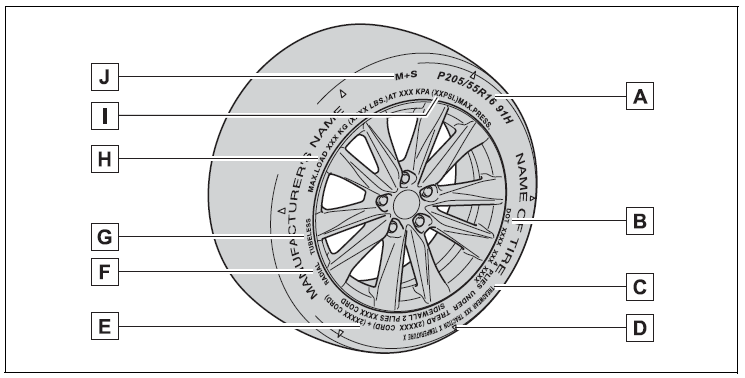
Typical tire symbols
- Tire size (P.391)
- DOT and Tire Identification Number (TIN) (P.391)
- Uniform tire quality grading
- For details, see “Uniform Tire Quality Grading” that follows.
- Location of treadwear indicators (P.312)
- Tire ply composition and materials
- Plies are layers of rubber-coated parallel cords. Cords are the strands which form the plies in a tire.
- Radial tires or bias-ply tires
- A radial tire has “RADIAL” on the sidewall. A tire not marked “RADIAL” is a bias-ply tire. TUBELESS or TUBE TYPE
- A tubeless tire does not have a tube and air is directly put into the tire. A tube type tire has a tube inside the tire and the tube maintains the air pressure.
- Load limit at maximum cold tire inflation pressure (P.393)
- Maximum cold tire inflation pressure (P.393) This means the pressure to which a tire may be inflated.
- Summer tires or all season tires (P.313) An all-season tire has “M+S” on the sidewall. A tire not marked “M+S” is a summer tire.
Typical DOT and Tire Identification Number (TIN)
Type A
- DOT symbol*
- Tire Identification Number (TIN)
- Tire manufacturer’s identification mark
- Tire size code
- Manufacturer’s optional tire type code (3 or 4 letters)
- Manufacturing week
- Manufacturing year
- The DOT symbol certifies that the tire conforms to applicable Federal Motor Vehicle Safety Standards.
Type B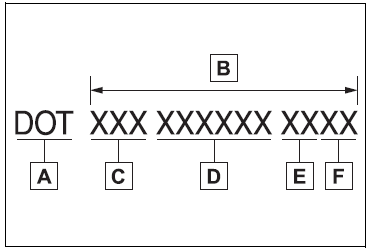
- DOT symbol*
- Tire Identification Number (TIN)
- Tire manufacturer’s identification mark
- Manufacturer’s code
- Manufacturing week
- Manufacturing year
- The DOT symbol certifies that the tire conforms to applicable Federal Motor Vehicle Safety Standards.
Tire size
Typical tire size information
The illustration indicates typical tire size.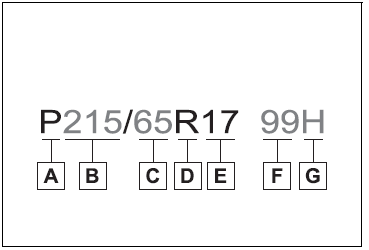
- Tire use (P = Passenger car,
- T = Temporary use)
- Section width (millimeters)
- Aspect ratio (tire height to section width)
- Tire construction code (R =
- Radial, D = Diagonal)
- Wheel diameter (inches)
- Load index (2 digits or 3 digits)
- Speed symbol (alphabet with one letter
Tire dimensions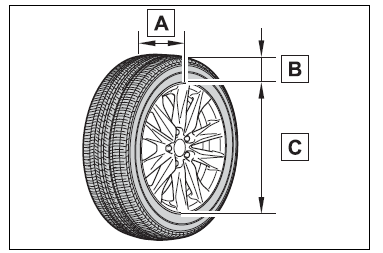
- Section width
- Tire height
- Wheel diameter
Tire section names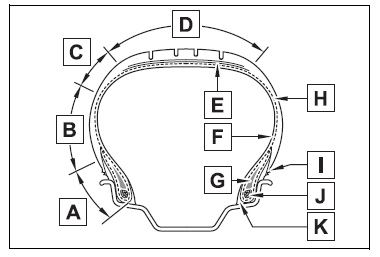
- Bead
- Sidewall
- Shoulder
- Tread
- Belt
- Inner liner
- Reinforcing rubber
- Carcass
- Rim lines
- Bead wires
- Chafer
Uniform Tire Quality Grading
This information has been prepared in accordance with regulations issued by the National Highway Traffic Safety Administration of the U.S. Department of Transportation. It provides the purchasers and/or prospective purchasers of Toyota vehicles with information on uniform tire quality grading. Your Toyota dealer will help answer any questions you may have as you read this information.
DOT quality grades
All passenger vehicle tires must conform to Federal Safety Requirements in addition to these grades. Quality grades can be found where applicable on the tire sidewall between tread shoulder and maximum section width. For example: Treadwear 200 Traction AA Temperature A
Treadwear
The treadwear grade is a comparative rating based on the wear rate of the tire when tested under controlled conditions on a specified government test course. For example, a tire graded 150 would wear one and a half (1 – 1/2) times as well on the government course as a tire graded 100. The relative performance of tires depends upon the actual conditions of their use. Performance may differ significantly from the norm due to variations in driving habits, service practices and differences in road characteristics and climate.
Traction AA, A, B, C
The traction grades, from highest to lowest, are AA, A, B and C, and they represent the tire’s ability to stop on wet pavement as measured under controlled conditions on specified government test surfaces of asphalt and concrete. A tire marked C may have poor traction performance. Warning: The traction grade assigned to this tire is based on braking (straight ahead) traction tests and does not include cornering (turning) traction.
Temperature A, B, C
The temperature grades are A (the highest), B, and C, representing the tire’s resistance to the generation of heat and its ability to dissipate heat when tested under controlled conditions on a specified indoor laboratory test wheel. Sustained high temperature can cause the material of the tire to degenerate and reduce tire life, and excessive temperature can lead to sudden tire failure. Grade C corresponds to a level of performance which all passenger car tires must meet under the Federal Motor Vehicle Safety Standard No. 109. Grades B and A represent higher levels of performance on the laboratory test wheel than the minimum required by law. Warning: The temperature grades of a tire assume that it is properly inflated and not overloaded. Excessive speed, underinflation, or excessive loading, either separately or in combination, can cause heat buildup and possible tire failure.
Glossary of tire terminology
| Tire related term | Meaning |
|
Cold tire inflation pressure |
Tire pressure when the vehicle has been parked for three hours or more, or has not been driven more than 1 mile or 1.5 km under that condition |
|
Maximum inflation pressure |
The maximum cold inflated pressure to which a tire may be inflated, shown on the sidewall of the tire |
| Tire related term | Meaning |
| Recommended inflation pres- sure | Cold tire inflation pressure recommended by a manufacturer |
|
Accessory weight |
The combined weight (in excess of those standard items which may be replaced) of automatic transmission, power steering, power brakes, power windows, power seats, radio and heater, to the extent that these items are available as fac-
tory-installed equipment (whether installed or not) |
|
Curb weight |
The weight of a motor vehicle with stan- dard equipment, including the maximum capacity of fuel, oil and coolant, and if so equipped, air conditioning and additional weight optional engine |
|
Maximum loaded vehicle weight |
The sum of:
(a) Curb weight (b) Accessory weight (c) Vehicle capacity weight (d) Production options weight |
|
Normal occupant weight |
150 lb. (68 kg) times the number of occu- pants specified in the second column of Table 1* that follows |
|
Occupant distribution |
Distribution of occupants in a vehicle as specified in the third column of Table 1* below |
|
Production options weight |
The combined weight of installed regular production options weighing over 5 lb. (2.3 kg) in excess of the standard items which they replace, not previously considered in curb weight or accessory weight, including heavy duty brakes, ride levelers, roof rack, heavy duty battery, and special trim |
|
Rim |
A metal support for a tire or a tire and tube assembly upon which the tire beads are seated |
| Tire related term | Meaning |
| Rim diameter (Wheel diame- ter) | Nominal diameter of the bead seat |
| Rim size designation | Rim diameter and width |
| Rim type designation | The industry manufacturer’s designation for a rim by style or code |
| Rim width | Nominal distance between rim flanges |
| Vehicle capacity weight (Total load capacity) | The rated cargo and luggage load plus 150 lb. (68 kg) times the vehicle’s designated seating capacity |
|
Vehicle maximum load on the tire |
The load on an individual tire that is deter- mined by distributing to each axle its share of the maximum loaded vehicle weight, and dividing by two |
|
Vehicle normal load on the tire |
The load on an individual tire that is deter- mined by distributing to each axle its share of curb weight, accessory weight, and nor- mal occupant weight (distributed in accor- dance with Table 1* below), and dividing by two |
| Weather side | The surface area of the rim not covered by the inflated tire |
|
Bead |
The part of the tire that is made of steel wires, wrapped or reinforced by ply cords and that is shaped to fit the rim |
| Bead separation | A breakdown of the bond between compo- nents in the bead |
|
Bias ply tire |
A pneumatic tire in which the ply cords that extend to the beads are laid at alternate angles substantially less than 90 degrees to the centerline of the tread |
|
Carcass |
The tire structure, except tread and side- wall rubber which, when inflated, bears the load |
| Chunking | The breaking away of pieces of the tread or sidewall |
| Cord | The strands forming the plies in the tire |
| Tire related term | Meaning |
| Cord separation | The parting of cords from adjacent rubber compounds |
|
Cracking |
Any parting within the tread, sidewall, or innerliner of the tire extending to cord material |
|
CT |
A pneumatic tire with an inverted flange tire and rim system in which the rim is designed with rim flanges pointed radially inward and the tire is designed to fit on the underside of the rim in a manner that encloses the rim flanges inside the air cav- ity of the tire |
|
Extra load tire |
A tire designed to operate at higher loads and at higher inflation pressures than the corresponding standard tire |
| Groove | The space between two adjacent tread ribs |
|
Innerliner |
The layer(s) forming the inside surface of a tubeless tire that contains the inflating medium within the tire |
| Innerliner separation | The parting of the innerliner from cord material in the carcass |
|
Intended outboard sidewall |
(a) The sidewall that contains a whitewall, bears white lettering, or bears manufac- turer, brand, and/or model name molding that is higher or deeper than the same molding on the other sidewall of the tire, or
(b) The outward facing sidewall of an asymmetrical tire that has a particular side that must always face outward when mounted on a vehicle |
|
Light truck (LT) tire |
A tire designated by its manufacturer as primarily intended for use on lightweight trucks or multipurpose passenger vehicles |
| Load rating | The maximum load that a tire is rated to carry for a given inflation pressure |
| Maximum load rating | The load rating for a tire at the maximum permissible inflation pressure for that tire |
| Tire related term | Meaning |
| Maximum permissible inflation pressure | The maximum cold inflation pressure to which a tire may be inflated |
| Measuring rim | The rim on which a tire is fitted for physical dimension requirements |
|
Open splice |
Any parting at any junction of tread, side- wall, or innerliner that extends to cord material |
| Outer diameter | The overall diameter of an inflated new tire |
|
Overall width |
The linear distance between the exteriors of the sidewalls of an inflated tire, including elevations due to labeling, decorations, or protective bands or ribs |
|
Passenger car tire |
A tire intended for use on passenger cars, multipurpose passenger vehicles, and trucks, that have a gross vehicle weight rating (GVWR) of 10,000 lb. or less. |
| Ply | A layer of rubber-coated parallel cords |
| Ply separation | A parting of rubber compound between adjacent plies |
|
Pneumatic tire |
A mechanical device made of rubber, chemicals, fabric and steel or other materi- als, that, when mounted on an automotive wheel, provides the traction and contains the gas or fluid that sustains the load |
|
Radial ply tire |
A pneumatic tire in which the ply cords that extend to the beads are laid at substan- tially 90 degrees to the centerline of the tread |
|
Reinforced tire |
A tire designed to operate at higher loads and at higher inflation pressures than the corresponding standard tire |
|
Section width |
The linear distance between the exteriors of the sidewalls of an inflated tire, exclud- ing elevations due to labeling, decoration, or protective bands |
| Sidewall | That portion of a tire between the tread and bead |
| Tire related term | Meaning |
| Sidewall separation | The parting of the rubber compound from the cord material in the sidewall |
|
Snow tire |
A tire that attains a traction index equal to or greater than 110, compared to the ASTM E-1136 Standard Reference Test Tire, when using the snow traction test as described in ASTM F-1805-00, Standard Test Method for Single Wheel Driving Trac- tion in a Straight Line on Snow-and
Ice-Covered Surfaces, and which is marked with an Alpine Symbol ( ) on at least one sidewall |
|
Test rim |
The rim on which a tire is fitted for testing, and may be any rim listed as appropriate for use with that tire |
| Tread | That portion of a tire that comes into con- tact with the road |
| Tread rib | A tread section running circumferentially around a tire |
| Tread separation | Pulling away of the tread from the tire car- cass |
|
Treadwear indicators (TWI) |
The projections within the principal grooves designed to give a visual indica- tion of the degrees of wear of the tread |
| Wheel-holding fixture | The fixture used to hold the wheel and tire assembly securely during testing |
Table 1 – Occupant loading and distribution for vehicle normal load for various designated seating capacities
| Designated seating capacity, Number of occupants | Vehicle normal load, Number of occupants | Occupant distribution in a normally loaded vehi- cle |
| 2 through 4 | 2 | 2 in front |
| 5 through 10 | 3 | 2 in front, 1 in second seat |
| Designated seating capacity, Number of occupants | Vehicle normal load, Number of occupants | Occupant distribution in a normally loaded vehi- cle |
|
11 through 15 |
5 |
2 in front, 1 in second seat, 1 in third seat, 1 in fourth seat |
|
16 through 20 |
7 |
2 in front, 2 in second seat, 2 in third seat, 1 in fourth seat |
Totoya 86 Best Accessories to Buy
[amalinkspro_table id=”32446″ new-window=”on” nofollow=”on” addtocart=”off” /]
Reference Links
Toyota 86 2022 Specifications User Manual
https://www.toyota.com/owners/resources/warranty-owners-manuals

